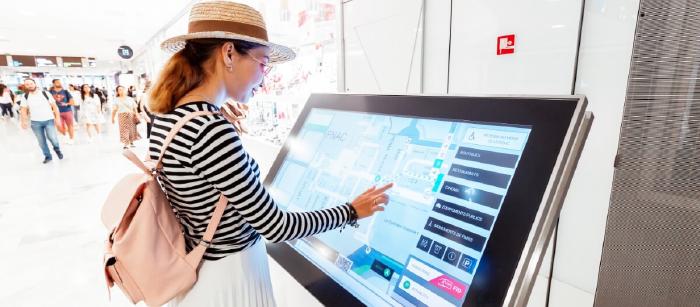
Jul 15 2022
10 min read


Jul
Ever wondered why modern cellphones are called smartphones? What changed between the earlier keypad mobile phones and the sleek calling devices we use today? A moment of retrospection will reveal that modern cellphones are more than just calling devices; they can now literally read our heartbeats and count our footsteps!
The concept of “smartness” extends beyond cell phones. Digital signage, those flat screens & billboards showing pre-arranged content, have also smartened up over the years.
Gone are the days when we had to transfer our favorite media files from a computer to a USB device, connect it to a screen, and continuously play the same content until someone reminded us that the holidays were over and it needed updating!
Enter smart digital signage. The coolest kid on the block! Look anywhere, and an intelligent screen greets you right back!
In this blog, we will delve into the definition of smart signage and explore some attributes of it. We will also learn how smart displays can be utilized and see a few mind boggling real-life examples.
Smart digital signage systems are digital screens that operate using advanced signage software. These intelligent features offer a wide range of benefits, such as streamlined content and screen management through automation, including the convenience of remote accessibility.
It facilitates personalized content distribution, catering to specific audiences or locations. An excellent illustration of smart signage technology is the interactive touchscreen kiosks frequently encountered in airports, ATMs, or retail check-out areas. These user-friendly displays showcase the potential of advanced software in enhancing customer engagement and delivering tailored information.
Smart solutions enable integrating the display systems with third-party applications, such as an organization’s internal dashboards or internal communication tools. These advanced functionalities are impossible in conventional digital signs like USB-driven signage.
Definition of Smart Signage: A smart digital signage is a display solution that optimizes results and reduces human supervision by different mechanisms, such as operational automation, interactivity, personalization of media, or remote screen & content management.
The terms “smart” and “intelligent” are often used interchangeably, but in tech, being smart does not always equate to being intelligent.
Smart digital signage truly becomes intelligent when it autonomously adapts and responds by predicting or analyzing the environment and human needs.
For example, an intelligent solution could be artificial intelligence (AI) digital signage in a retail store. This system reads customers’ demographics and moods, enabling it to display personalized product suggestions. Such a solution exemplifies both smartness and intelligence in digital signage.
On the other hand, if we consider an interactive digital menu board that allows restaurant-goers to self-order food, then that display is only smart signage, not intelligent.
Try for FreeAutomation is one of the most important benefits of smart digital signage systems. A smart signage software will allow you to schedule your media on a screen or group of screens. Your assigned content will be automatically published at the specified date and time. Not just one, or two, or three; users can create as many schedules as they want.
Besides content scheduling, these signage solutions offer users ready-to-use content applications to ensure dynamic media playback on screen. These apps can show an extensive range of real time content like:
Weather updates
Live traffic updates
Fresh news headlines
Moment-by-moment sports scores
Or something as simple as the current time on a world clock.
Remote management enables users to access their signage systems from any location, thanks to the power of the internet and the design of modern digital signage players.
Both external digital signage players and Smart TVs operated by System on a Chip (SoC) can connect to the internet, facilitating wireless and remote data transfer from the Content Management System (CMS) to the screen. This contrasts with USB players that require physical connections for sharing media files.
The presence of cloud-based smart signage platforms further enhances remote accessibility. While modern digital signage players impart remote access and download capabilities, a cloud signage software takes it further by allowing remote access to the digital signage command center or CMS, enabling seamless control and management from anywhere.
Smart solutions can communicate with other intelligent devices and third-party applications, e.g., Adobe Illustrator for iPad through API and other integrations.
This network-to-network communication enables the display software to retrieve and present data from private servers on the screen.
An excellent example is the implementation of smart electronic signage displays in office settings. The corporate TV software can be integrated with an organization’s internal applications like project management tools, CRMs, ERPs, etc., showcasing various Key Performance Indicators (KPIs) and business intelligence dashboards.
One real life example is Walmart integrating smart digital signs , interwoven with the store’s inventory and internal systems with real-time product info and deals to shoppers, suggesting alternatives when shelves run bare. For employees, these signs are data dashboards, displaying performance metrics and schedules, keeping everyone tuned in. It’s a win-win, orchestrated by clever digital signage that’s more than just pretty pictures.
Digital signage systems often incorporate interactivity, enabling a two-way communication channel between users and the digital screen. This interactive capability plays a crucial role in delivering personalized experiences to individuals.
Behind these interactive displays, numerous “smart” functionalities are at work, including computational power, sensory capabilities (such as touch recognition), and device automation (automated ON/OFF functionality). These combined features enhance user engagement and facilitate seamless interactions with the signage system.
As highlighted earlier, intelligent displays represent a powerful subset of smart signage technology. Within this realm, there exists a vast array of possibilities to explore and tailor screens for a specific goal.
What sets these intelligent screens apart is their ability to perceive and interpret surroundings, filter sensory inputs, and autonomously make decisions on our behalf. This opens up new avenues for enhancing user experiences and delivering advanced functionalities that cater to our evolving needs.
Now that AI has entered the market, it can be used to gather data on user interactions. For example, integrating AI with signage systems can help recognize high foot traffic areas in a shopping mall and automatically adjust its content to target the specific demographic present, such as displaying toy ads during school holidays. This level of responsiveness and adaptability showcases a significant advantage over competitors whose systems may lack such sophisticated AI-driven decision-making capabilities.
A smart digital signage system is not easily susceptible to hacking, data theft, or sabotage. These smart software applications are guarded by high-standard security protocols like end-to-end encryption, https, authentication, and access controls.
Smart systems are so flexible and adaptive that they find application in almost every domain and industry. Here are some common applications of these signage solutions:
Multi-touch video walls
Dynamic advertising displays
QR-enabled digital menu boards
Interactive kiosks
IoT projects
Digital window displays
Large-scale globe-spanning networks of digital signage
Smart outdoor digital billboards
Smart door signage
AI-screens for trigger-based content display
Smart signage has gained popularity across organizations of all sizes as a means to promote products and foster brand engagement. It is vastly employed for streamlining operations in areas like transportation ticketing and retail check-outs.
Let’s take a look at real-life examples yielding remarkable results for their owners.
Fanta’s innovative out-of-home campaign asked passersby to click a photo of themselves with the signage in the background. Next, the campaign participants were asked to upload this photo on Instagram with the hashtag #FantaTastesLike. Once the photo is uploaded, the smart signage immediately prints the photo and it delivers it through the Fanta Printergram.
Singapore’s Changi airport has revolutionized air transportation and air travel. The video below shows how the smart interactive displays generate the passenger’s boarding pass and securely processes the baggages at the connected baggage drop belt.
McDonald’s has long established itself as the king of disruptive promotional campaigns. In 2018, the QSR chain came up with yet another fun campaign to promote its Maestro Burger. People could simply wave into the air mimicking an orchestra conductor, and the tasty Maestro burger on screen dances to the tune. Nothing beats a dancing burger, right?
One of the greatest aspects of smart signage is that it doesn’t have to break the bank. Remote accessibility, content scheduling, and software integrations and customizations are standard features offered by leading digital signage brands. The cost of digital signage depends on the complexity of your business requirements.
If you’re considering implementing an innovative signage solution for your business, Pickcel is an acclaimed brand that offers a perfect blend of advanced features and reasonable pricing. Reach out to our sales team to request a free demo and see how we can meet your specific needs!
Take complete control of what you show on your digital signage & how you show it.
Start Free Trial Schedule My Demo
Jul 15 2022
10 min read

Apr 29 2021
6 min read

Oct 25 2022
8 min read

Oct 18 2022
10 min read